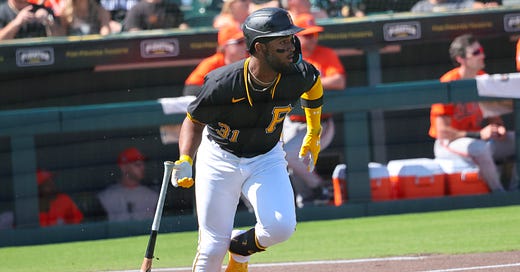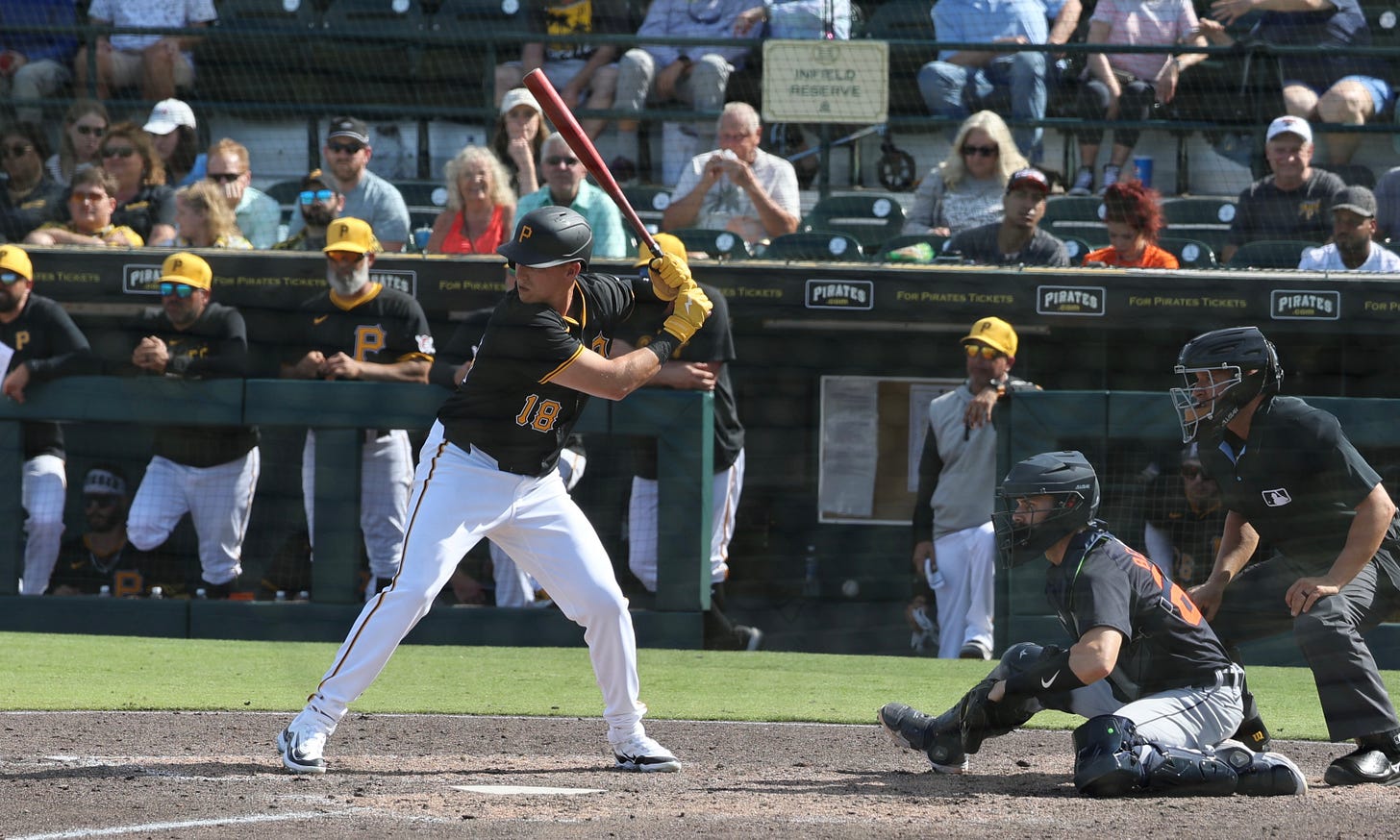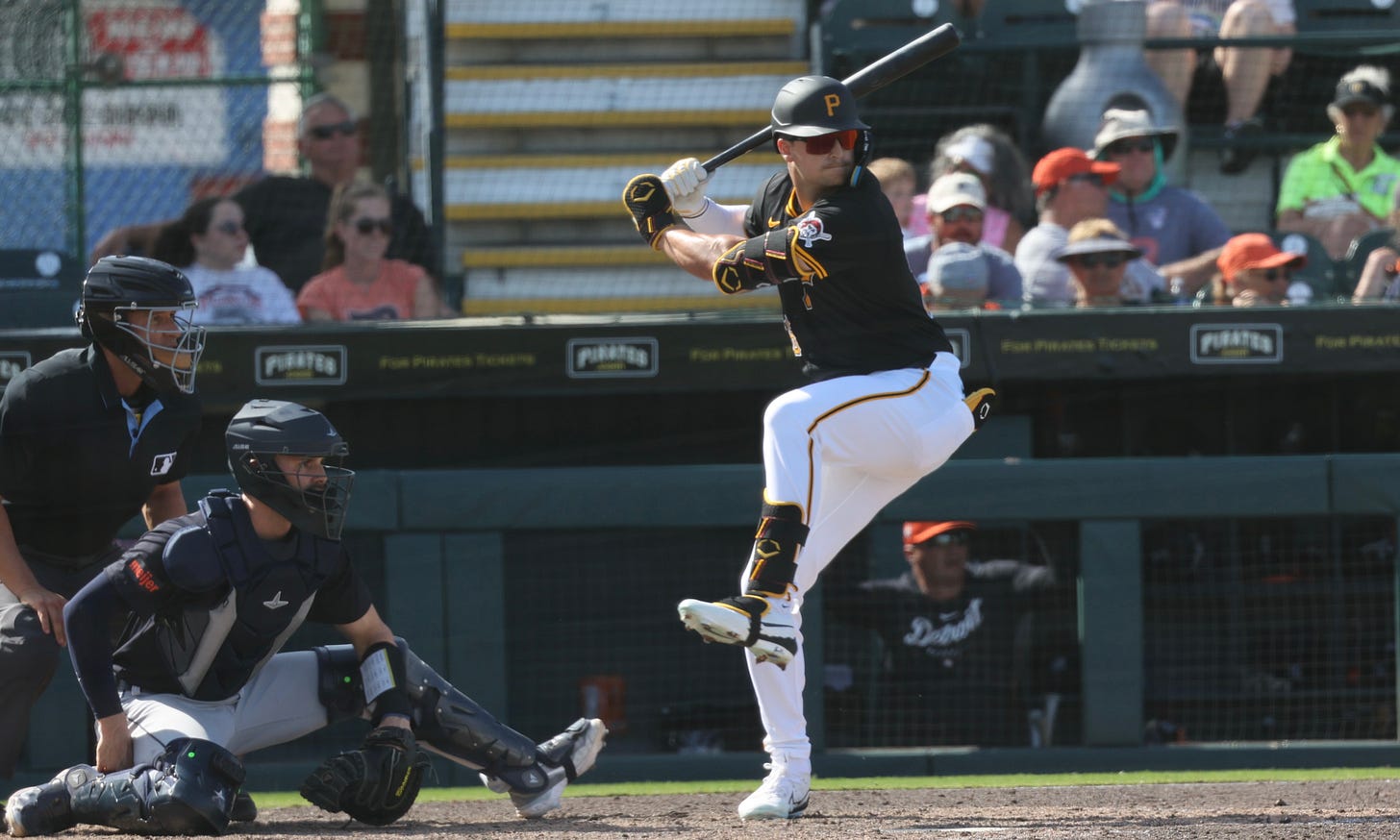Pirates' 2024 Minor League Recaps: Indianapolis
Cast heavy on minor league veterans helps Indy to winning record.
Indianapolis finished 77-70 in 2024. To a large extent, they relied on veteran players rather than prospects. This isn’t exactly unusual in AAA, given the attrition that takes place in all farm systems and the practice for teams to use their AAA rosters effectively as taxi squads. Indy used minor league veterans pretty heavily, but the team also was heavy on AAAA players who got time with the Pirates, like Edward Olivares, Joshua Palacios, and a bunch of relievers and prospects who’ve struggled to hang onto major league jobs, like Jack Suwinski, Ji-Hwan Bae, Liover Peguero, and Alika Williams.
Indy’s hitting was a little better than league average. The hitters were sixth in the 20-team league in scoring, first easily in batting average, fifth in OBP, and eighth in slugging. They were an anomaly in a system that was heavily populated by big swingers who walked a lot and struck out a whole lot; they were only 17th in home runs, 15th in walks, and 12th in strikeouts. In looking at raw hitting numbers for this team, bear in mind that offense was notoriously high in the International League this year. The average team scored 5.13 runs per game. I’ve seen two common explanations: either a juiced ball or just a lot of bad pitching.
The pitchers were average, with an ERA of 4.85 in a league where the norm was 4.83. They walked the fourth-fewest, struck out the sixth-most, and were about average in allowing both hits and home runs.
Catchers
Obviously, the guy who mattered here was Henry Davis. We all know how he struggled in the majors. For Indy, he hit .307/.401/.555, with 13 home runs in 57 games. His strikeout and walk rates were pretty reasonable, and he even stole eight bases in nine tries. One defensive stat was pretty alarming: He threw out just one of 37 base stealers. The team as a whole was very bad at stopping the running game, so maybe a lot of it was the pitchers, but 1-for-37 is extreme. (Davis did throw out 20% in the majors.)
Jason Delay served effectively as the Pirates’ fourth catcher. He caught 45 games for Indy and hit respectably, with a .287/.357/.360 line, although that left his OPS 46 points below league average. Organizational guys Grant Koch, who got into three games with the Pirates, and Dylan Shockley caught 56 games combined, and struggling former prospect Carter Bins caught 15. Shockley and Bins hit decently in their brief playing time, while Koch didn’t hit at all.
There were also some rehab appearances from Yasmani Grandal, Joey Bart and Endy Rodriguez. The latter provided a scare at the end of the season with what supposedly was just arm fatigue.
Infielders
The Indy infield was the spot for players trying to step forward and get established in the majors. The successful one, as we all know, was Nick Gonzales. He started focusing on hitting the ball rather than watching it and produced a big 34-game stint with a 1.029 OPS. That got him back to the majors and, while he didn’t hit consistently, he looks to be settled in as a starter.
The two regulars in the infield throughout the season were Liover Peguero and Malcom Nunez. Peguero actually led Indy in games played at both second and short, although he spent two-thirds of his time at the latter spot. He hit decently, with a .259/.319/.410 line that left him with an OPS that was 34 points below league average. The difference between Peguero and the average hitter was entirely the result of his walk rate. Defensively, he was more reliable than in the past, with 11 errors in 125 starts in the middle infield. He ended up with a three-game callup to close out the season.
Nunez played at the corners, spending two-thirds of his time at third. He just isn’t developing as a hitter, putting up a weak .250/.310/.365 this year. He’s still 23, but his OPS was just four points higher than it was last year in AAA.
Alika Williams got into 41 games with Indy, divided between second, third and short. He hit slightly above league average, at 311/384/396. He saw nearly as much action with the Pirates and didn’t hit at all. Williams is 25 now, which made his role in blocking Nick Yorke especially odd.
Speaking of which . . . Yorke seemed to be in the process of breaking out when the Pirates acquired him from Boston. He really broke out with Indy, hitting .355/.431/.507 in 40 games, averaging a double nearly every other game. The Pirates delayed calling Yorke up until mid-September just because. A position could be the biggest issue for him. He spent most of his time, both before and after the trade, at second, but Gonzales was an above-average defender in 2024. Yorke also saw time at third, short, and in the outfield corners. With Indy, he started seven games in center, the only times he’s ever played there.
Probably overlooked, Andres Alvarez was an infield mainstay for Indy. He played between 20 and 29 games each at second, third and short. He was also a solid hitter, with a .777 OPS.
The primary first baseman was veteran Jake Lamb, although Seth Beer and various outfielders saw time there. Lamb was released at mid-season, probably pursuant to an out-clause, but soon resigned. He got off to a fast start, with big numbers in March and April, and seemed like a possibility for a callup. He stopped hitting after that and finished with a below-average .744 OPS. Beer hit better, with a .814 OPS in 44 games.
Outfielders
The Indy outfield was heavily populated by AAAA players and struggling, maybe prospects. Some veterans didn’t last the season, like Jose Rojas, Dustin Peterson, and Joe Perez. Another veteran, Gilberto Celestino, put up a .704 OPS over 67 games, then got sent off in a minor trade. And the Pirates released a struggling Canaan Smith-Njigba at mid-season, effectively closing the books on one of Ben Cherington's many failed trades, the Jameson Taillon deal. (Maikol Escotto is still around for now but clearly going nowhere.)
The outfield had three players who looked like prospects at one time or another. Most prominent is Jack Suwinski, who got sent down at the end of July after struggling badly in the majors both at the plate and in the field. He started 5-for-52 in AAA, then hit .297 in 128 ABs the rest of the way. His strikeout rate was exactly the same in AAA as in the majors, 29%, so it’s hard to say he’s solved his issues.
Ji Hwan Bae alternated between center and second for Indy, riding an unsustainable .430 BABIP to a .342/.433/.504 line. His walk and K rates were pretty good in the minors, but as always, they collapsed in his brief time with the Pirates, leaving him with a .463 OPS there. He’s 25 and has two options left, but his minor-league success just doesn’t seem to translate to the majors.
Indy’s most-used outfielder, in fact, the only player other than Peguero and Nunez who exceeded 100 games, was Matt Gorski. He had what seemed like a big year offensively, catching fire with nine home runs in May and finishing with an .841 OPS and 23 long balls. Despite getting by far the worst production from center field of any team in MLB, though, the Pirates never called Gorski up. His swing-and-miss tendencies obviously are scaring off not just the Pirates but the other 29 teams that have twice passed him over in the Rule 5 draft despite the power, speed, and legit center-field ability.
The AAAA outfield contingent was Edward Olivares, Billy McKinney, and Joshua Palacios. Olivares started the season as the Pirates’ regular right fielder, a good sign that Ben Cherington had no intention of taking the season seriously. He lasted 55 games as one of the worst players in MLB before being sent to Indy, where he had a below-average .722 OPS. He’s now a free agent, as is McKinney, who missed a large part of the season. He had a .866 OPS with Indy and played ten games for the Pirates.
Palacios is still around after missing the majority of the season with injuries. The Pirates talk about him like he’s a prospect, but he’s 29 now. He put up an .861 OPS in 50 games for Indy and got into 23 games with the Pirates. They brought him up at the end of the season so he could get some time in the majors, which turned out to be a whopping nine plate appearances. Whether that means they consider him as a potential piece going forward or whether it was just a random move produced by some algorithm or something is hard to say. Palacios is out of options.
Finally, there was Billy Cook. He got into 30 games for Indy after arriving from Baltimore and had an .875 OPS, along with high walk and K rates. In 16 games with the Pirates, he showed surprising speed and defensive ability, including some time in center. He also got some time at first. He hit three home runs in the majors but racked up 19 strikeouts and no walks.
Starting Pitchers
Indianapolis ran through 46 pitchers, plus a couple of position players, in 2024. By my count, at least 14 of them are no longer with the organization as I’m writing, and that number will probably grow by the time you read this. Of all of the departed, probably the only one who raises a blip of interest is Quinn Priester, now with Boston. I think I’ll pass over the rest. I’m guessing you’re pretty familiar with Paul Skenes, who made seven starts with Indy, and Jared Jones, who made three rehab appearances.
Of the 28 pitchers who started games for Indy, only three started more than nine. The most notable was Domingo German, whose season was delayed until mid-May by some sort of visa problem. That truncated season still managed to include some interesting maneuvers. German didn’t pitch very well for Indy and opted out in July when he didn’t get called up, only to re-sign with the Pirates. He still didn’t pitch well, but the Pirates called him up in August. A string of terrible outings got him outrighted a month later. He finished with a 5.04 ERA in AAA.
The other two most frequent starters were Luis Cessa and lefty Michael Plassmeyer. Cessa signed in June after being released by the Royals. He had a 5.26 ERA for Indy. Plassmeyer served as a swingman and had great walk and K rates but was saddled with a 7.93 ERA anyway.
The big feature at Indy was, of course, many of the Pirates’ top pitching prospects. Fittingly, once Skenes graduated from the prospect ranks, Bubba Chandler replaced him both at the top of those and at Indy. Chandler took some big steps forward at Altoona during June, then made his last seven starts in AAA. He fanned 12.4 per nine and, maybe more importantly, walked only 3.4 while posting a 1.83 ERA. For the full season, Chandler struck out 148 in 119.2 IP.
Mike Burrows worked his way back from Tommy John, making ten appearances for Indy and then one, in which he got the win, for the Pirates. Burrows’ performance in AAA was uneven, as expected; he had a 1.41 WHIP and 4.06 ERA. His walk and K rates, though, were good, at 3.6 and 10.8 per nine innings. In his last AAA outing, he fanned ten over five innings.
Braxton Ashcraft moved up to Indy after a good showing at Altoona. In 19.1 IP in AAA, he allowed just one earned run. He had several IL stints, though, with what the Pirates said is elbow soreness that doesn’t show structural damage. He threw just one inning over the season’s final two and a half months.
Finally, Thomas Harrington made eight Indy starts after posting a 2.24 ERA at Altoona. In 46 innings, he walked just 1.6 per nine innings and had a WHIP of 0.94. Harrington had a low K/9 in AAA of 7.4, so that could be something to watch for. He finished the season on the IL with what the Pirates say was a minor knee problem.
Indy’s starters included the usual raft of veteran depth guys, apart from the ones mentioned above. Easily the most successful was Jake Woodford, whom the Pirates signed after he was released by the White Sox. He had a 2.44 ERA in ten AAA games but struggled badly in seven games with the Pirates. He’s now a free agent.
Former first-round pick Daulton Jefferies, came to the Pirates in May in a very minor trade after failing to stick with the Giants. He had a 6.23 ERA in five starts with Indy, but the Pirates promoted him anyway. He made four relief appearances, pitching badly in two and well in two, then went on the IL with elbow discomfort and didn’t return except to pitch one inning at the end of August. He’s still on the 40-man roster.
Other veteran starters included lefties Eric Lauer and Cam Alldred. Neither pitched well, and both have moved on. Another lefty, Nick Dombkowski, served in a swing role at both Indy and Altoona. He pitched well in AA but not in AAA. Righty Aaron Shortridge also served in a swing role after missing half the season. He had a 5.18 ERA. Shortridge has moved slowly through the system and is now 27.
Relief Pitchers
A very large majority of Indy’s relief work was done by minor-league veterans. A few relievers were there briefly, sometimes on rehab, before returning to the Pirates. That included Carmen Mlodzinski, Colin Holderman, and lefty Ryan Borucki. Kyle Nicolas started the season with Indy, allowed just two hits, and fanned 13, but walked nine in 10.2 IP, then got called up.
The closest thing to a relief prospect with Indy was J.C. Flowers. He got demoted to Altoona after posting an ERA of 9.00 over 20 innings.
The bullpen mainstays were all veterans. Connor Sadzeck and lefty Geronimo Franzua led the staff in appearances with 48 and 47, respectively, and Sadzeck led in saves with nine. Neither was very effective, posting ERAs in the mid-4s with high walk rates. Another lefty, Brady Feigl, got into 39 games. He had much better peripherals than the first two but still had a 4.05 ERA. Feigl had one very bad outing for the Pirates.
Four righties and one lefty turned their Indianapolis stints into callups. Ryder Ryan and Brent Honeywell had ERAs in the upper-4s and weak K rates, but ended up in Pittsburgh. Ryan pitched poorly in 15 games with the Bucs and is now a free agent. Honeywell got into two major league games, then was lost on waivers to the Dodgers, for whom he had a 2.62 ERA over 18 games. Lefty Justin Bruihl, signed after the Reds released him, didn’t pitch that well in 18 games with Indy, posting a 3.93 ERA with a high WHIP and a high walk rate. He gave up six earned runs in 5.2 IP with the Pirates and is now a free agent.
Two relievers are still on the 40-man roster. Isaac Mattson pitched well for Indy in 29 games, with a 3.19 ERA and 11.4 K/9, although he had a high walk rate. He got into three late-season games with the Pirates, walking five but allowing just one hit in 5.1 IP.
Ben Heller probably looked the most promising of the AAA relievers after working his way back from a spring injury. In 30 games, he had much better peripherals than his 3.55 ERA, including a 1.00 WHIP and a whopping 15.0 K/9. He got a two-game stint with the Pirates in June that went badly in a huge way, was outrighted, then returned in September and pitched a lot better before going on the IL near season’s end. Of all the minor league veteran relievers, he could be the one to watch, depending on whether he stays on the roster.
There were a bunch of other guys who appeared in relief with Indy without making any sort of mark. Most have moved on and the rest probably soon will.
This site is 100% reader-supported, with no revenue coming from ads. If you enjoy our work, consider becoming a paid member today.
You will not only help the site grow but also get access to our fantastic premium content, which includes our Top 25 rankings and full-player write-ups, video breakdowns, and any features that come from my on-site trips.
Bucs On Deck is a reader-supported publication. To receive new posts and support my work, consider becoming a free or paid subscriber.









Thank you, WTM, for another great analysis of AAA. Always look forward to your articles!
I was always a fan of Osvaldo Bido. I always thought he could give you a good 4-5 IP, twice through a lineup. But he always seemed to have a tough time after that.
I really like him on the 40 man as SP depth(like a 7th SP). He’s 28 years old and Oakland has him under control for a while. He was actually one of the top MILB UFAs last offseason and got signed right away.
The Pirates never should’ve let him get away.